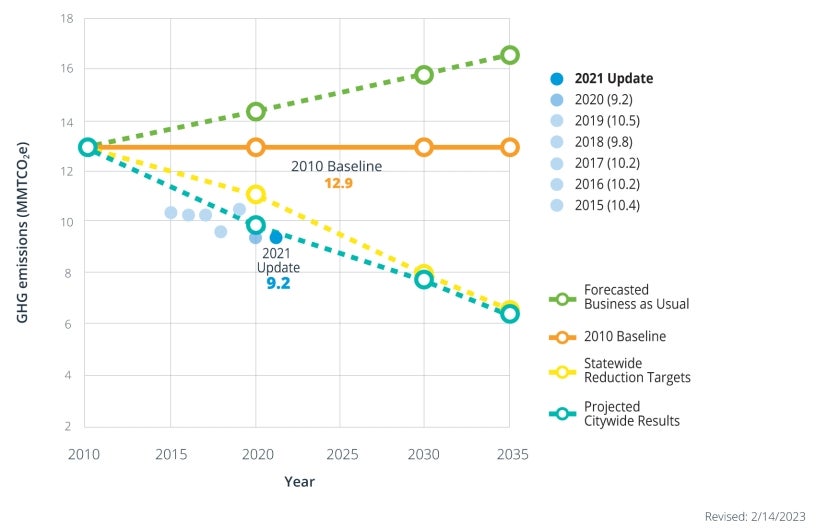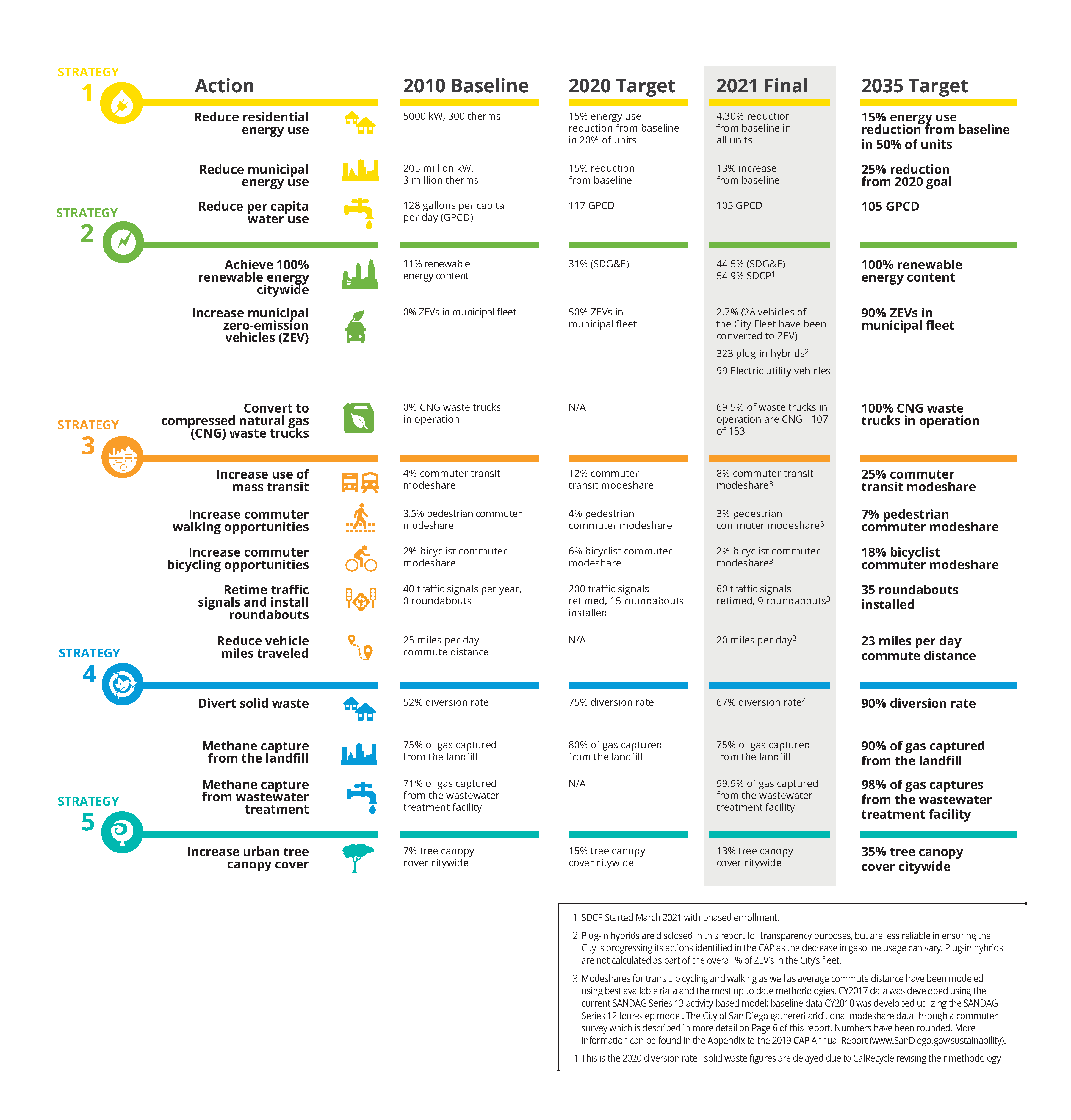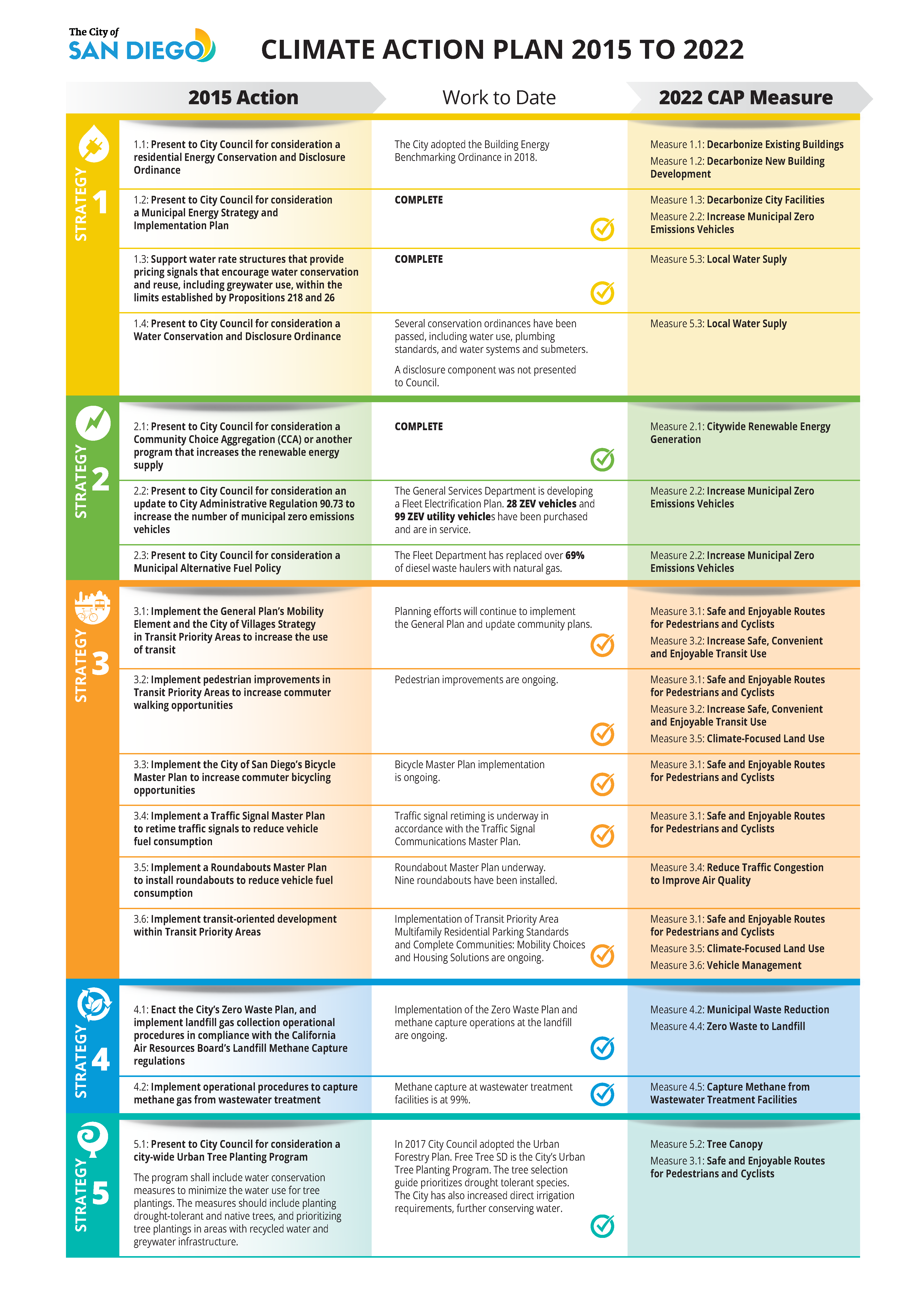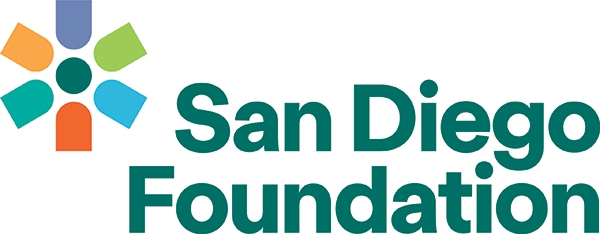
City of San Diego
2015 Climate Action Plan
Final Report
2021 Greenhouse Gas Emissions Inventory|Accomplishments of the 2015 CAP|Partnerships & Community|Final Reporting on the 2015 CAP|Appendix
Letter from the Chief Sustainability Officer
In 2015, the City of San Diego (City) adopted one of the most ambitious Climate Action Plans (CAPs) in the country. At the time, the declaration that we would cut greenhouse gas (GHG) emissions in half by 2035 made national and international news. We are proud of our City for taking such an impactful and forward-looking leap in 2015, but the pace of climate change has quickened. Therefore, we have adopted an updated CAP that sets a new goal of net-zero GHG emissions by 2035. This report captures the progress made to date that catapults us into the next phase of our climate action work in San Diego.
The City fulfilled our promise to report on progress, releasing six annual reports along with citywide GHG inventories. In this report, and as we wrap up our efforts under the City’s prior CAP, we dig into the details of the 2015 CAP to identify success stories, opportunities for improvement and lessons learned to apply to the 2022 CAP implementation.
Looking forward, the 2022 Climate Action Implementation Plan (Implementation Plan), released at the end of February, takes all the lessons learned from the past seven years and puts tools in the hands of City leaders, non-profit partners and the public to build accountability and transparency. Chief among these tools are the Annual Departmental Work Plans and the Implementation Cost Analysis (ICA). The Annual Departmental Work Plans detail each City Department’s work for the upcoming year to implement their respective CAP actions. The ICA meets the long-awaited need for attaching resource allocation estimates to each CAP action. By using realistic estimates based on operations budgets, we position ourselves to identify and pursue funding opportunities as they arise. This work cannot be done without comprehensive partnerships both internally and externally. We will continue to work as a City across all City departments to implement our climate action and equity goals. External partnerships with various business sectors and stakeholders will continue to be essential to our success by spotlighting the value of innovation and creativity that are embedded in our community.
The time for climate action is now and the City of San Diego is prepared to meet our ambitious goal of net-zero by 2035. We have a moral imperative to approach climate work through an equity lens so that our City truly achieves a just transition to a healthy, sustainable and prosperous San Diego. Our team is extremely proud of the work completed to date and is beyond excited to continue our goal of making San Diego a healthier and more sustainable place for all of us, and for Our Climate, Our Future!

Shelby Busó
Chief Sustainability Officer
The 2021 Greenhouse Gas Emissions Inventory
The total GHG emissions from San Diego in 2021 were approximately 9.2 million metric tons CO2e (MMT CO2e, where CO2e means the amount of CO2 emissions that would have the same global warming impact as the greenhouse gas being reported). Decreases in GHG emissions from electricity consumption, transportation, solid waste and water use offset some increase seen from natural gas consumption and wastewater production year-over-year. The 2019 inventory in the 2020 Annual Report has been revised to ensure consistency with the 2020–2021 GHG inventory as well as with the 2019 baseline GHG inventory in the updated CAP. The revision reflects updated data and models supplied by agencies not managed by the City, which became available after the release of 2020 Annual Report in November 2020.

Accomplishments of the 2015 Climate Action Plan
Community Choice Aggregation / San Diego Community Power
Moving beyond state mandates and timelines, San Diego Community Power was created as a not-for-profit Joint Power Authority (JPA) to provide 100% clean and renewable energy to San Diegans. SDCP began operations on March 1, 2021 and had a Phase 3 enrollment rate of 507,634, or just under 97% for both commercial and residential customers in the City of San Diego by the end of 2022. The majority of Phase 3 customers enrolled under a 50% renewable energy service level (PowerOn) and can upgrade to a 100% renewable energy service level (Power100). The City is enrolled in the Power100 plan, so all feasible municipal facilities are powered by electricity generated from 100% renewable sources. The JPA includes the cities of San Diego, Chula Vista, Encinitas, La Mesa, Imperial Beach and National City, as well as the County of San Diego.
Climate Equity
The 2015 CAP acknowledged that some degree of climate change will occur regardless of City action, and that disadvantaged communities would therefore continue to face climate-related health issues. That CAP called for addressing environmental justice through meaningful participation in the decision-making process related to climate action. To follow through on that commitment, in 2019, the City convened a group of advocates and community leaders came together to form the Climate Equity Working Group, an informal committee to help guide the creation of the Climate Equity Index (CEI). The working group helped map “access to opportunity” throughout the City. Areas with lower access to opportunity were identified to start to address decades-long disparities. Referred to as Communities of Concern, those communities are now eligible to benefit from the multi-million-dollar Climate Equity Fund (CEF), a stand-alone funding source, dedicated to projects in Communities of Concern, that will improve climate adaptation and resilience. The CEF targets annual funding toward building City infrastructure that will allow Communities of Concern to be more resilient and adapt to climate change. The Sustainability and Mobility Department’s Climate Action & Equity Team oversees the allocations of this fund in coordination with the Department of Race and Equity and the Mayor's Office.
"Sea Change" Within the City
 One of the most important outcomes of the 2015 CAP was the internal re-organization of the City’s operation toward sustainability. At the time the first CAP was written, City Departments and staff didn’t typically have ongoing and direct conversations of sustainability and equity. The lessons learned from implementing the 2015 CAP have placed the City in a strong position to move toward even more aggressive targets. Some of these include:
One of the most important outcomes of the 2015 CAP was the internal re-organization of the City’s operation toward sustainability. At the time the first CAP was written, City Departments and staff didn’t typically have ongoing and direct conversations of sustainability and equity. The lessons learned from implementing the 2015 CAP have placed the City in a strong position to move toward even more aggressive targets. Some of these include:
Sustainability and Mobility - In recognition of the role played by City-wide transportation in total GHG emissions, the Mobility Department was combined with the Sustainability Department to create the Sustainability and Mobility Department.
Council Item Review - All items brought in front of City Council and committees are required to highlight how the action—policy, program, project, or allocation—implement the City’s Climate Action Plan. Where a connection is difficult to identify, Departments are encouraged to reflect on CAP goals and, where possible, do more to address sustainability in every action and operation.
Sustainability Round Tables - Departments come together on a bi-monthly basis to openly discuss successes and challenges in implementing the CAP. By keeping an open dialog, we remove barriers and establish a space to develop and deploy best practices.
Ongoing Fiscal Planning - Recognizing that CAP implementation will require significant financial investment, the City brought in the Energy Policy Initiatives Center (EPIC) to perform an Implementation Cost Analysis (ICA). The ICA provides estimates intended to better understand the overall scale of need and identify specific measures where the City will need to seek outside resources or partnerships. These cost estimates will be continuously refined and provided via a new implementation tool, the CAP Annual Departmental Work Plan, which is integrated into the budget process. As will be detailed in a new internal City Administrative Regulation, the CAP Annual Departmental Work Plans will lay out which CAP actions a given department will address in the upcoming fiscal year with the resources allocated, and will be completed by each implementing department annually as part of the budget process.
Resilience - In 2020, the City completed a climate change vulnerability assessment to identify risks and potential hazards facing our City, building on the resiliency planning identified as a priority within the 2015 CAP. We then finalized a companion document to the CAP that focuses on adaptation measures called Climate Resilient SD. Climate Resilient SD provides strategies to prepare, respond and recover from potential climate change hazards, including extreme heat, wildfires, sea-level rise, flooding and drought. The City also continues to serve on the Advisory Board of the San Diego Regional Climate Collaborative. The Climate Collaborative, housed at The Nonprofit Institute of the University of San Diego, was established in 2011 as a network for public agencies to advance climate change solutions that mitigate GHG emissions and adapt to the effects of climate change. Partnering with academia, nonprofit organizations, and business and community leaders, the Collaborative raises the profile of regional leadership, shares expertise and leverages resources.
Capital Improvement Program - Council Policy 800-14 was amended in December 2022. The updated policy now includes a Sustainability and Conservation factor in the prioritization for Capital Improvement Program projects.
Partnerships & Community
The City cannot achieve sustainability goals on our own. Strong partnerships, community involvement, and capitalizing on opportunities to advocate for San Diego's priorities are necessary for transformational change.
Climate Action Plan Review Committee
We would like to thank the members of the Climate Action Plan Review Committee (CAPRC), an ad-hoc advisory group that was created by Mayor Gloria in 2022 to give the public an opportunity to review and provide feedback on the drafted 2022 CAP update, including proposed strategies and actions, goals and targets, and all other content related to the CAP. The CAPRC moved quickly to provide vital support and feedback to the benefit of the CAP. They lent their knowledge of environmental, business, energy, equity, and labor issues and helped ensure that the CAP serves all San Diegans.
Sustainability Energy Advisory Board
From 2003 to 2023 the Sustainable Energy Advisory Board (SEAB) assisted the City in moving towards a cleaner energy future, both in municipal operations and in public policy. Some of their notable achievements include ongoing advisement in Federal and State energy legislation, liaising with SDG&E on local energy issues, and supporting the creation of San Diego Community Power (SDCP), a Community Choice Aggregation (CCA). The City extends appreciation to all SEAB members who volunteered their time and expertise during the nearly 20 years of the board’s tenure. The City will continue to listen to citizens, making use of subject matter experts with two new City Boards for climate action and resiliency, expected to form in Spring 2023.
Carbon Disclosure Project
The Carbon Disclosure Project (CDP) is a nonprofit running the world’s largest environmental reporting platform. The City of San Diego is one of 165 U.S. cities reporting to CDP and has done so consistently for 11 years. CDP is focused on helping investors, companies, cities and states understand and manage their environmental impact with an emphasis on data standardization. CDP is also the designated reporting platform for the Race to Zero and the Global Covenant of Mayors. The data CDP hosts are made publicly available to promote transparency and accountability. In 2021, the City of San Diego received its highest rating of an A-, significantly improving on results in previous years.
Community Partners
The City continues to foster partnerships with trusted community-based organizations (CBOs) to increase efficiency and effectiveness of climate action. These partnerships have been critical in the preparation of the 2022 CAP. To have equitable outcomes, we must prioritize action and investment where the need is greatest by involving impacted community members in the City’s decision-making process early and through continual partnerships. By partnering with CBOs in Communities of Concern and increasing their capacity for targeted engagement, the City seeks to empower the respective communities to have a voice in City policies and increase the level of engagement.
Final Reporting on the 2015 CAP
The goal of the 2015 CAP was to lower the City’s annual GHG emissions to below the amount released in 2010, the baseline year. At the time, establishing a trajectory that would reduce the City’s annual emissions to 40% of the 2010 baseline by the year 2035, and would continue to reduce emissions in following years was consistent with the state of California goals and with the California Air Resources Board (CARB) recommendations. The City chose actions with progress that could be measured, and set targets at several time points. Here we report on the City's progress on each action at the close of the 2015 CAP. Table 1 (below) shows actual performance on each metric in 2021, compared to the targets set for 2020 and 2035.
The summary tables below and the emissions table at the beginning of this report show that while overall emissions reductions stayed on track with the 2015 CAP goals, progress on individual actions and strategies has been mixed. The City has largely stayed on track with milestones set by the 2015 CAP for renewable energy use, vehicle miles traveled reductions, and waste diversion. However, progress has been slower in decarbonizing buildings and vehicles, shifting trips to more sustainable transportation modes, and growing the City’s urban tree canopy. The City has recommitted to strong implementation measures in these areas and learning from past challenges in the new 2022 CAP.
New research shows that global temperatures are increasing more rapidly than had been predicted when the 2015 CAP was released. To grapple with this new challenge, the goal of the 2022 CAP is to reach net-zero carbon emissions by 2035, which is a far more ambitious goal than was set by the 2015 CAP. Table 2 (below) shows how the actions from the 2015 CAP carry forward to the 2022 CAP. Only the actions from the 2015 CAP are shown here; the increased scope of the new CAP required the addition of many new actions that are not reflected in this table. For a full listing of actions in the new 2022 CAP, please see Our Climate, Our Future - The City of San Diego Climate Action Plan.
Table 1. Measured performance for all 2015 CAP actions at the end of its adoption period

Table 2. Progress on 2015 CAP actions and their inclusion in the new 2022 CAP


































